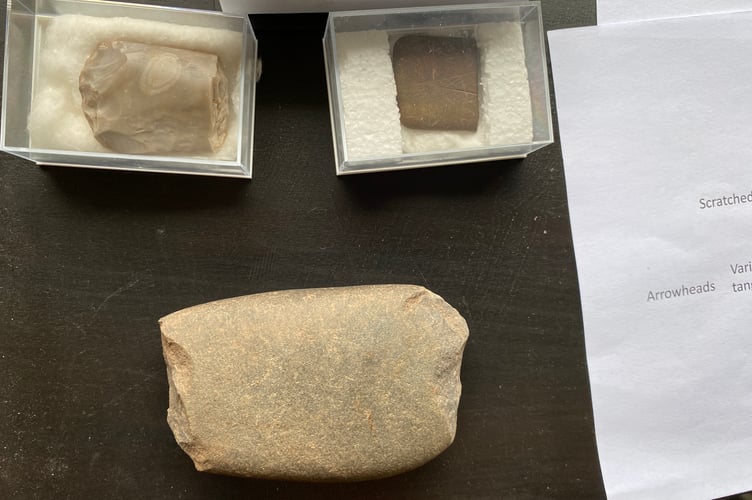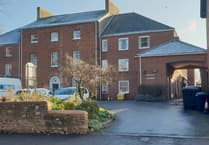A RETIRED geologist has discovered what could be a lost Bronze Age settlement in his back garden after learning to identity artefacts by watching Time Team.
Dr Andrew Beckly has amassed a horde of more than 2,500 artefacts including blades, axes and arrowheads, after a chance discovery in his back garden sparked a mission to map a forgotten chapter of prehistory.
The enormous collection began with a single arrowhead, which Dr Beckly turned up while sifting earth in his back garden. He said the discovery “shot the history of the area back by 4,000 years.”
Dr Beckly, who said he had just finished rewatching the popular Channel 4 history programme Time Team with his wife, credited the show in helping him to quickly identify the arrowhead when it turned up in his garden sieve. He said: “I was sieving earth in the back garden to get the stones out of it. And during lockdown you couldn’t get building materials and I was building a wall and was using the stones for that.
“Finding the arrowhead was the starting point. I went to my wife and said ‘guess what I found’ - obviously she didn’t have a clue. But it shot the history of the area back by 4,000 years.
“I knew enough to recognise an arrowhead like that, I was a geologist and I am an avid fan of Time Team; me and my wife rewatched them all not so long ago. We always watch Time Team.
“All knowledge helps and you learn things without knowing it. That and visiting museums and having a general interest but otherwise I might not have known.”

Dr Beckly wasn’t sure whether the arrowhead was a ‘stray shot’ or evidence of something much bigger, so he expanded his search to nearby fields. There he unearthed evidence which could challenge historian’s assumptions about life in Bronze Age Britain. He said: “I decided to go back to basics and learn what these things are. I went and got a couple of books on prehistoric flintwork and gained an outline knowledge. But primarily I let the artefacts teach me.
“I drew every single piece in detail to scale on graph paper across four volumes of books. That’s how I built my knowledge of the material, I let it do the educating rather than trying to fit the books to what I found. What I have discovered is repeat examples of things here which don’t appear in the textbooks.
“My gut feeling is this would have been a great location for historic hunter gatherers. I have heard frustrations expressed that it is commonly thought prehistory took place in the east of the country because they had Doggerland.
“As a result there is a perception by many that the south west is pretty much ignored. But it would have been warm and the Channel would have only been a river at this time, so it would have been easy to come across from the continent.
“The alternate view is we actually had an Atlantic province rather than just the eastern province. It shifts the balance away from everything being in the east.”

Referencing the work of archaeologist and Time Team star Francis Pryor, Dr Beckly said he had ‘good reason’ to think the Wellington hillside would have been the “perfect place” for our ancestors, in part because what is now the M5 motorway would have made for an attractive route for migrating animals to travel along.
He said his findings, which include the discovery of so-called microliths, small tools which date to the lifetime of wooly mammoths, were evidence for continuous settlement of the area for almost 10,000 years which “nobody had noticed before.” he added: “There is an assumption there isn’t very much prehistory in the west country and now this suggests there may be an awful lot more than we realised.”
Dr Beckly said when he first brought his findings to heritage experts, they were dismissed as ‘rubbish’ - before later apparently recognising them as Bronze Age tools. The find could now be examined by Heritage England who would carry out an assessment of the collection.

Their findings could confirm Dr Beckly’s suggestion that one of his tools points toward evidence of trade and even potentially immigration between France and England before the dawn of history. Dr Beckly raised the possibility, after he said he discovered a ‘bladelet’ which appears very similar to samples usually found in France. He said: “There may be things here which shift the notch. There are things here like this bladelet which look like samples found in France. We could have evidence of connections 10,000 years ago.
“It could tell us there was trade and migration between France and the UK 10,000 years ago, but we don’t know.
“There are 2500 artefacts here indicating the existence of culture and people for as far back as 10,000 years ago. We are at an early stage in the evaluation but we could be looking at things which are previously undescribed.”
The Somerset Heritage Centre has been approached for comment.




